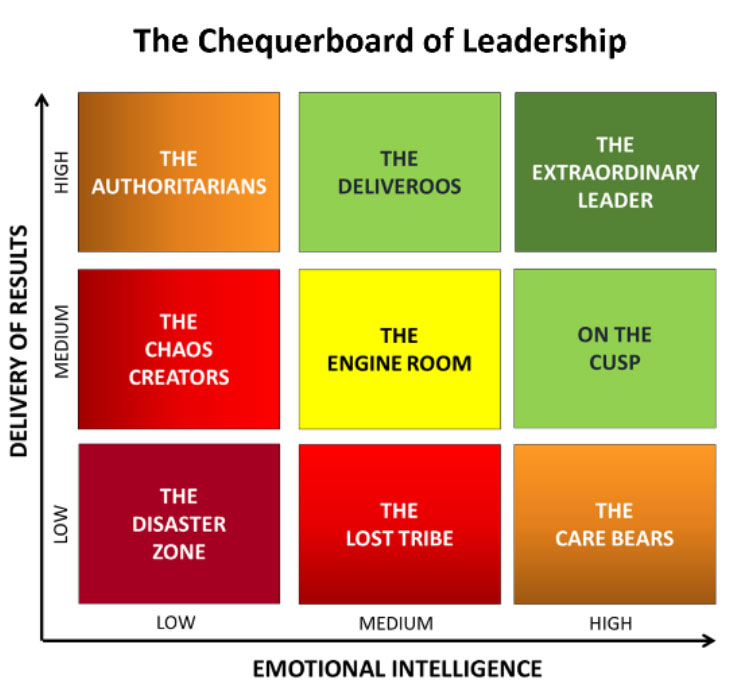Extraordinary Leadership

In my 25+ years of enabling business leaders to lead successful and sustainable change, I have determined that extraordinary leaders possess three core, critical skills:
- The ability to deliver results
- The ability to influence, motivate and empower people (Emotional Intelligence)
- The ability to build extraordinary leadership teams
Poor leaders possess none of these skills. Extraordinary leaders possess all three – in abundance.
Extraordinary leaders are focused on the delivery of outcomes that are sustainable. They have honed their influencing skills and worked on their emotional intelligence, knowing that when it comes to leadership, EQ trumps IQ hands down. And that 21st Century leadership is a team game, not a solo pursuit.
They also realise that every one of these attributes requires continual development. The future of their careers and their organisations depend upon it.
Extraordinary Leaders … of leaders
When it comes to the first two attributes of individual leadership (Delivery and EQ), each different type of leader between the two extremes of woeful and extraordinary can be plotted on a simple matrix that I have called ‘The Chequerboard of Leadership’.
The position on the board is not set in stone. No matter which square a leader may occupy today, they do not have to be imprisoned in that cell forever. They can move – preferably upwards and to the right – as long as they are aware of their position on the board and possess the desire to change.
Where would you place yourself on the board? Where would other people place you?
Where would you place your manager?
Where would you place each member of your organisation’s leadership team?
Why?
While the leaders who are floundering in The Disaster Zone may be irredeemable in their current role, every other type of leader on the chequerboard can transform to become better leaders.
‘Chaos Creators’ and ‘Authoritarians’ are renowned for delivering results that are short-term and leaving pandemonium in their wake. Helping them to move ‘eastwards’, developing their emotional intelligence skills, will enable them to deliver results that are sustainable.
Members of ‘The Lost Tribe’ and ‘Care Bears’ can move ‘northwards’, developing their delivery skills, which they will need to do if they wish to become relevant in the future.
The most populous square on the board is the one in the centre. ‘The Engine Room’ is also the square that contains a treasure trove of hidden potential. One global CEO once described it as his “permafrost middle-management layer”, but he was wrong. The Engine Room is full of leaders and managers that are so often taken for granted – and yet they are the backbone of the business.
This square can roughly be divided into two:
- ‘Safe Pairs of Hands’ – competent managers that every business needs. Their leadership competence and effectiveness can be enhanced.
- ‘Latent Leadership Potential’ – hidden leaders whose development will deliver substantial returns for the business.
Too many organisations still conflate leadership with people management, which is a mistake. In today’s world of flattening organisational structures, virtual teams, hybrid working, outsourcing, partnerships and accelerating change, leadership is about influencing people across departments and outside of the organisation – to deliver the outcomes you need.
Leadership today is not about hierarchy. It is about influence. And leaders exist at all levels of your organisation.
Extraordinary Leadership Teams
The third trait of an extraordinary leader is the ability to build leadership teams that trust one another and work together to deliver shared objectives. 21st Century leadership is a team game, not a solo pursuit.
Leadership teams exist on a spectrum – from dysfunctional to extraordinary. They also exist at every level of an organisation – and each team must be functioning as well as it can if the unit, division, department or organisation is to succeed.
Organisations with dysfunctional leadership teams consistently under-perform. Some are weakened so much by the actions and inactions of their most senior team that they have to be rescued or become take-over targets. Some go under.
Dysfunctional leadership teams are eventually and inevitably replaced – starting from the top. But so much damage is often done in the meantime that organisations can become shadows of their former selves. One reason is that dysfunctional leadership teams create dysfunctional cultures that mirror the tribal, warring behaviour at the top. Another is that dysfunctional leadership teams are too busy fighting one another to appreciate what makes their business special or to recognise the opportunities, let alone seize them.
But even dysfunctional teams can be transformed – as long as the team leader is ready, willing and able to do so. They can move across the spectrum – first to ‘Fragile’, then onto ‘Developing’ and finally to ‘Extraordinary’.
Transforming dysfunctional leadership teams is challenging, but the alternative is far worse – as so many leaders have discovered.
No transformation is easy and there will almost inevitably be casualties along the way, but it is critical for the success of the organisation or department, the success of every employee and, of course, for the success of the leaders themselves.
Here is an abridged version of the spectrum:
Where would you place the team you lead on the spectrum?
Where would you place the team of which you are a member on the spectrum?
Where would you place your organisation’s leadership team?
Why?
Written by Campbell Macpherson.
Add CEOWORLD magazine to your Google News feed.
Follow CEOWORLD magazine headlines on: Google News, LinkedIn, Twitter, and Facebook.
This report/news/ranking/statistics has been prepared only for general guidance on matters of interest and does not constitute professional advice. You should not act upon the information contained in this publication without obtaining specific professional advice. No representation or warranty (express or implied) is given as to the accuracy or completeness of the information contained in this publication, and, to the extent permitted by law, CEOWORLD magazine does not accept or assume any liability, responsibility or duty of care for any consequences of you or anyone else acting, or refraining to act, in reliance on the information contained in this publication or for any decision based on it.
Copyright 2024 The CEOWORLD magazine. All rights reserved. This material (and any extract from it) must not be copied, redistributed or placed on any website, without CEOWORLD magazine' prior written consent. For media queries, please contact: info@ceoworld.biz
SUBSCRIBE NEWSLETTER










